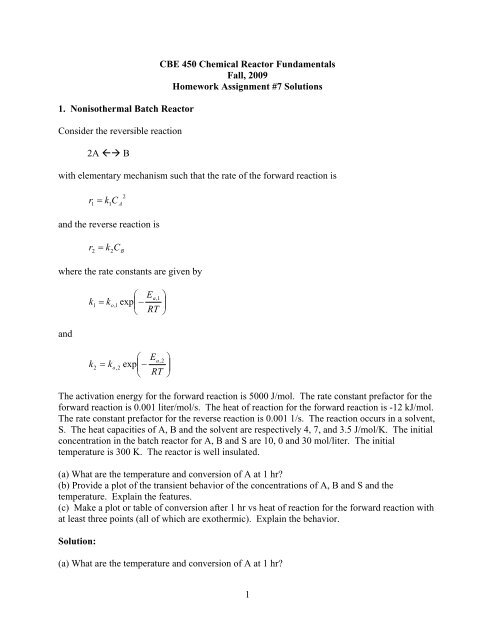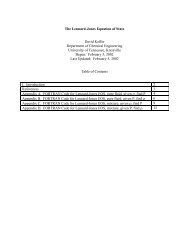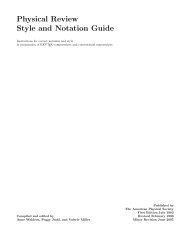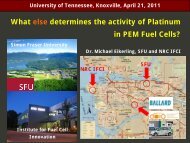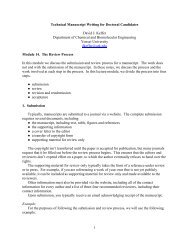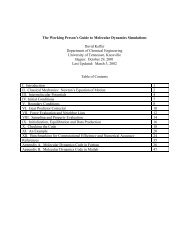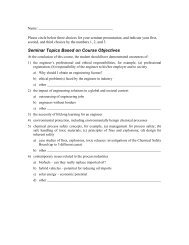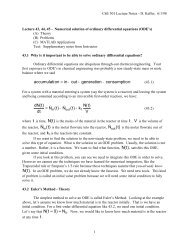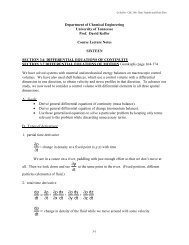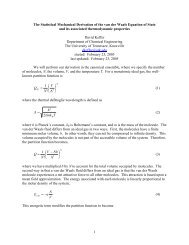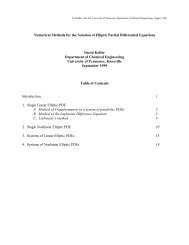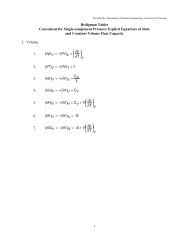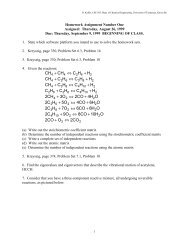Homework 7 Solutions
Homework 7 Solutions
Homework 7 Solutions
Create successful ePaper yourself
Turn your PDF publications into a flip-book with our unique Google optimized e-Paper software.
1. Nonisothermal Batch Reactor<br />
Consider the reversible reaction<br />
2A B<br />
CBE 450 Chemical Reactor Fundamentals<br />
Fall, 2009<br />
<strong>Homework</strong> Assignment #7 <strong>Solutions</strong><br />
with elementary mechanism such that the rate of the forward reaction is<br />
2<br />
1<br />
k1C<br />
A<br />
r <br />
and the reverse reaction is<br />
r 2<br />
k2C B<br />
where the rate constants are given by<br />
and<br />
E<br />
<br />
a,1<br />
k1 ko,1<br />
exp<br />
RT<br />
<br />
<br />
<br />
E<br />
<br />
a,2<br />
k2 ko,2<br />
exp<br />
RT<br />
<br />
<br />
<br />
The activation energy for the forward reaction is 5000 J/mol. The rate constant prefactor for the<br />
forward reaction is 0.001 liter/mol/s. The heat of reaction for the forward reaction is -12 kJ/mol.<br />
The rate constant prefactor for the reverse reaction is 0.001 1/s. The reaction occurs in a solvent,<br />
S. The heat capacities of A, B and the solvent are respectively 4, 7, and 3.5 J/mol/K. The initial<br />
concentration in the batch reactor for A, B and S are 10, 0 and 30 mol/liter. The initial<br />
temperature is 300 K. The reactor is well insulated.<br />
(a) What are the temperature and conversion of A at 1 hr<br />
(b) Provide a plot of the transient behavior of the concentrations of A, B and S and the<br />
temperature. Explain the features.<br />
(c) Make a plot or table of conversion after 1 hr vs heat of reaction for the forward reaction with<br />
at least three points (all of which are exothermic). Explain the behavior.<br />
Solution:<br />
(a) What are the temperature and conversion of A at 1 hr<br />
1
I used the following input file:<br />
function dydt = sysodeinput(x,y,nvec);<br />
%<br />
% one reversible reaction in solvent, S<br />
% 2A B<br />
%<br />
% sample usage:<br />
% [y,x]=sysode(2,1000,0,10,[10,0,40,300]);<br />
%<br />
CA = y(1); % mol/liter<br />
CB = y(2);<br />
CS = y(3);<br />
T = y(4); % K<br />
%<br />
% stoichiometry<br />
%<br />
nuA1 = -2;<br />
nuB1 = 1;<br />
nuS1 = 0;<br />
nuA2 = 2;<br />
nuB2 = -1;<br />
nuS2 = 0;<br />
%<br />
% rate law<br />
%<br />
ko1 = 1.0e-3; % liter/mole/sec<br />
Ea1 = 5000; % J/mol<br />
R = 8.314; %J/mol/K<br />
DUR1 = -12000.0; %J/mol<br />
k1 = ko1*exp(-Ea1/(R*T)); % liters/mole/sec<br />
r1 = k1*CA*CA; % mole/liter/sec<br />
%<br />
ko2 = 1.0e-3; % 1/sec<br />
Ea2 = Ea1 - DUR1; % J/mol<br />
R = 8.314; %J/mol/K<br />
DUR2 = -DUR1;<br />
k2 = ko2*exp(-Ea2/(R*T)); % 1/sec<br />
r2 = k2*CB; % mole/liter/sec<br />
%<br />
% pure component heat capacities<br />
%<br />
CvA = 4.0; %J/mol/K<br />
CvB = 7.0; %J/mol/K<br />
CvS = 3.5; %J/mol/K<br />
%<br />
% mole fractions<br />
%<br />
CT = CA + CB + CS;<br />
xA = CA/CT;<br />
xB = CB/CT;<br />
xS = CS/CT;<br />
%<br />
% mixture heat capacity<br />
%<br />
Cvmix = xA*CvA + xB*CvB + xS*CvS;<br />
%<br />
% mole and energy balances<br />
%<br />
dydt(1) = nuA1*r1 + nuA2*r2;<br />
dydt(2) = nuB1*r1 + nuB2*r2;<br />
2
dydt(3) = nuS1*r1 + nuS2*r2;<br />
dydt(4) = -(DUR1*r1 + DUR2*r2)/(CT*Cvmix);<br />
I used the following command<br />
[y,x]=sysode(2,1000,0,3600,[10,0,40,300]);<br />
I generated the plot of the transient behavior (the solution for part B).<br />
2.5<br />
2<br />
1<br />
2<br />
3<br />
4<br />
1.5<br />
y<br />
1<br />
0.5<br />
0<br />
0 500 1000 1500 2000 2500 3000 3500 4000<br />
x<br />
And the final line of the output file<br />
3.6000000e+003 7.0091175e-002 4.6495441e-001 1.0000000e+000 2.0468110e+000<br />
This plot and output file was normalized. Since the initial concentration of A was 10 mol/liter,<br />
the final concentration of A is 0.701 mol/liter. The conversion is<br />
X<br />
A<br />
C<br />
1<br />
C<br />
A<br />
A,<br />
in<br />
0.701<br />
1<br />
0.9299<br />
10<br />
The temperature is 614.0 K.<br />
(b) Provide a plot of the transient behavior of the concentrations of A, B and S and the<br />
temperature. Explain the features.<br />
3
The plot is provided above. The temperature rises because the reaction is exothermic. The<br />
concentration of the solvent is unchanged because it does not participate in the reaction and the<br />
reactor volume is constant. The concentration of A decreases since it is the reactant. The<br />
concentration of B rises half as fast as the concentration of A based on the stoichiometry of the<br />
reaction.<br />
(c) Make a plot or table of conversion after 1 hr vs heat of reaction for the forward reaction with<br />
at least three points (all of which are exothermic). Explain the behavior.<br />
We can repeat the process used in part (a) for two other values of the the heat of reaction.<br />
The results are below:<br />
heat of reaction for<br />
the forward reaction<br />
(kJ/mol)<br />
concentration of A<br />
(mol/liter)<br />
temperature<br />
conversion<br />
-6 1.000 451.9 0.9000<br />
-12 0.701 614.0 0.9299<br />
-24 0.497 942.1 0.9503<br />
As the heat of reaction increases the temperature naturally increases. As the temperature<br />
increases, the rates of both the forward and reverse reactions increase. However, the activation<br />
energy of the forward reaction is a constant at 5000 J/mol. The activation energy of the reverse<br />
reaction is not independent and is the E a,1 – H R,1 , and so increases with an increase in<br />
magnitude in the heat of reaction. Thus the forward reaction is favored and conversion<br />
increases.<br />
2. Nonisothermal Batch Reactor<br />
Consider the system of irreversible reactions<br />
A B<br />
A C<br />
A + B D<br />
with elementary mechanism such that the rate of the forward reaction is<br />
r k1C A<br />
, 1<br />
r 2<br />
k2C<br />
, and A<br />
r3 k3C A<br />
CB<br />
All reactions have an Arrhenius dependence on temperature<br />
k<br />
j<br />
Ea,<br />
j<br />
k<br />
<br />
o, j<br />
exp <br />
RT<br />
<br />
<br />
<br />
4
where the reaction properties are given in the table below<br />
reaction k o (1/s or liter/mol/s) E a (J/mol) heat of reaction<br />
(kJ/mol)<br />
1 1.0 4000 0<br />
2 1.0 3000 0<br />
3 1.0 2000 -20<br />
The reaction occurs in a solvent, S. The heat capacities of A, B, C, D and the solvent are<br />
respectively 4.0, 3.0, 5.0, 6.0, and 4.0 J/mol/K. The initial concentration in the batch reactor for<br />
A, B, C, D and S are 10, 0, 0, 0 and 40 mol/liter. The initial temperature is 300 K. The reactor is<br />
well insulated.<br />
(a) What are the steady state temperature and concentrations of each component<br />
(b) What operating condition could you change if you want to form a higher ratio of C to D<br />
Demonstrate.<br />
Solution:<br />
(a) What are the steady state temperature and concentrations of each component<br />
I used the following input file:<br />
function dydt = sysodeinput(x,y,nvec);<br />
%<br />
% three reactions in solvent, S<br />
% A --> B<br />
% A --> C<br />
% A + B --> D<br />
%<br />
% sample usage:<br />
% [y,x]=sysode(2,1000,0,10,[10,0,0,0,40,300]);<br />
%<br />
CA = y(1); % mol/liter<br />
CB = y(2);<br />
CC = y(3);<br />
CD = y(4);<br />
CS = y(5);<br />
T = y(6); % K<br />
%<br />
% stoichiometry<br />
%<br />
nuA1 = -1;<br />
nuB1 = 1;<br />
nuC1 = 0;<br />
nuD1 = 0;<br />
nuS1 = 0;<br />
%<br />
nuA2 = -1;<br />
nuB2 = 0;<br />
nuC2 = 1;<br />
nuD2 = 0;<br />
nuS2 = 0;<br />
%<br />
nuA3 = -1;<br />
nuB3 = -1;<br />
5
nuC3 = 0;<br />
nuD3 = 1;<br />
nuS3 = 0;<br />
%<br />
% rate law<br />
%<br />
ko1 = 1.0; % 1/sec<br />
Ea1 = 4000; % J/mol<br />
R = 8.314; %J/mol/K<br />
DUR1 = 0.0; %J/mol<br />
k1 = ko1*exp(-Ea1/(R*T)); % 1/sec<br />
r1 = k1*CA; % mole/liter/sec<br />
%<br />
ko2 = 1.0; % 1/sec<br />
Ea2 = 3000; % J/mol<br />
R = 8.314; %J/mol/K<br />
DUR2 = 0;<br />
k2 = ko2*exp(-Ea2/(R*T)); % 1/sec<br />
r2 = k2*CA; % mole/liter/sec<br />
%<br />
ko3 = 1.0; % liter/mole/sec<br />
Ea3 = 2000; % J/mol<br />
R = 8.314; %J/mol/K<br />
DUR3 = -20000.0; %J/mol<br />
k3 = ko3*exp(-Ea3/(R*T)); % liters/mole/sec<br />
r3 = k3*CA*CB; % mole/liter/sec<br />
%<br />
% pure component heat capacities<br />
%<br />
CvA = 4.0; %J/mol/K<br />
CvB = 3.0; %J/mol/K<br />
CvC = 5.0; %J/mol/K<br />
CvD = 6.0; %J/mol/K<br />
CvS = 4.0; %J/mol/K<br />
%<br />
% mole fractions<br />
%<br />
CT = CA + CB + CC + CD + CS;<br />
xA = CA/CT;<br />
xB = CB/CT;<br />
xC = CC/CT;<br />
xD = CD/CT;<br />
xS = CS/CT;<br />
%<br />
% mixture heat capacity<br />
%<br />
Cvmix = xA*CvA + xB*CvB + xC*CvC + xD*CvD + xS*CvS;<br />
%<br />
% mole and energy balances<br />
%<br />
dydt(1) = nuA1*r1 + nuA2*r2 + nuA3*r3;<br />
dydt(2) = nuB1*r1 + nuB2*r2 + nuB3*r3;<br />
dydt(3) = nuC1*r1 + nuC2*r2 + nuC3*r3;<br />
dydt(4) = nuD1*r1 + nuD2*r2 + nuD3*r3;<br />
dydt(5) = nuS1*r1 + nuS2*r2 + nuS3*r3;<br />
dydt(6) = -(DUR1*r1 + DUR2*r2 + DUR3*r3)/(CT*Cvmix);<br />
I used the following commands<br />
[y,x]=sysode(2,1000,0,10,[10,0,0,0,40,300]);<br />
6
I generated the following plot<br />
2<br />
1.8<br />
1.6<br />
1.4<br />
1<br />
2<br />
3<br />
4<br />
5<br />
6<br />
1.2<br />
y<br />
1<br />
0.8<br />
0.6<br />
0.4<br />
0.2<br />
0<br />
0 1 2 3 4 5 6 7 8 9 10<br />
x<br />
From the output file<br />
9.9500000e+000 3.4365569e-006 6.1307264e-002 4.2862813e-001 2.5503059e-001 1.0000000e+000 1.8525516e+000<br />
9.9600000e+000 3.3907845e-006 6.1307264e-002 4.2862815e-001 2.5503060e-001 1.0000000e+000 1.8525517e+000<br />
9.9700000e+000 3.3456219e-006 6.1307265e-002 4.2862816e-001 2.5503061e-001 1.0000000e+000 1.8525517e+000<br />
9.9800000e+000 3.3010607e-006 6.1307266e-002 4.2862818e-001 2.5503063e-001 1.0000000e+000 1.8525517e+000<br />
9.9900000e+000 3.2570931e-006 6.1307267e-002 4.2862820e-001 2.5503064e-001 1.0000000e+000 1.8525518e+000<br />
1.0000000e+001 3.2137111e-006 6.1307268e-002 4.2862821e-001 2.5503065e-001 1.0000000e+000 1.8525518e+000<br />
These values are normalized by the inlet concentration of A for A, B, C, and D, by the inlet<br />
concentration of S for S and by the inlet temperature for T. Unscaling them yields<br />
CA = 3.2e-005 mol.liter<br />
CB = 0.61 mol.liter<br />
CC = 4.29 mol.liter<br />
CD = 2.55 mol.liter<br />
CS = 40 mol.liter<br />
T = 555.8 K<br />
(b) What operating condition could you change if you want to form a higher ratio of C to D<br />
Demonstrate.<br />
7
You could change the initial temperature of the reactor. If the initial temperature is 300 K as in<br />
the problem above, then the final ratio of C to D is 1.68. If the initial temperature is 100 K, the<br />
ratio of C to D is 2.4. Lowering the temperature works because D is kinetically favored.<br />
Lowering the temperature reduces the kinetic advantage.<br />
8


